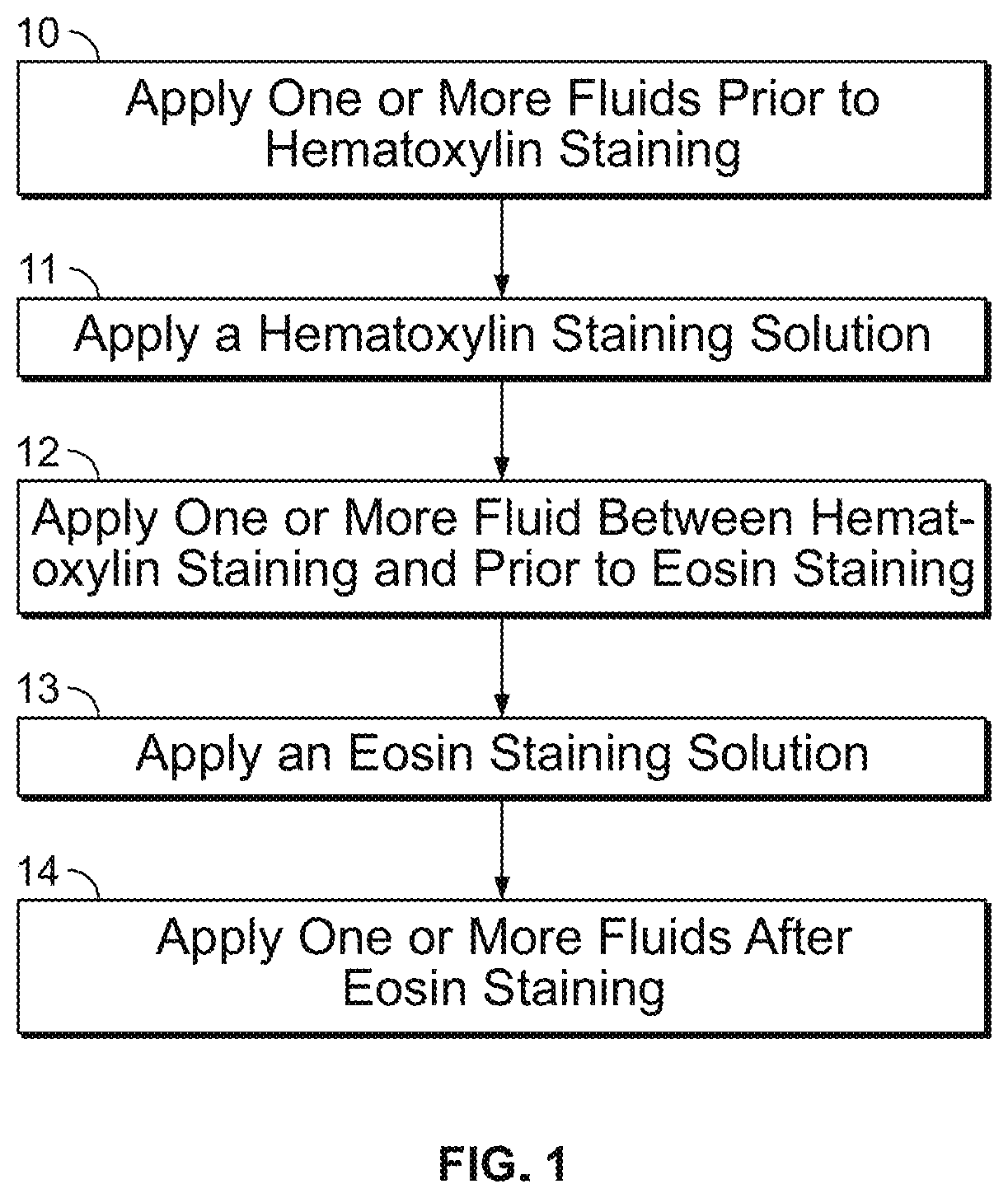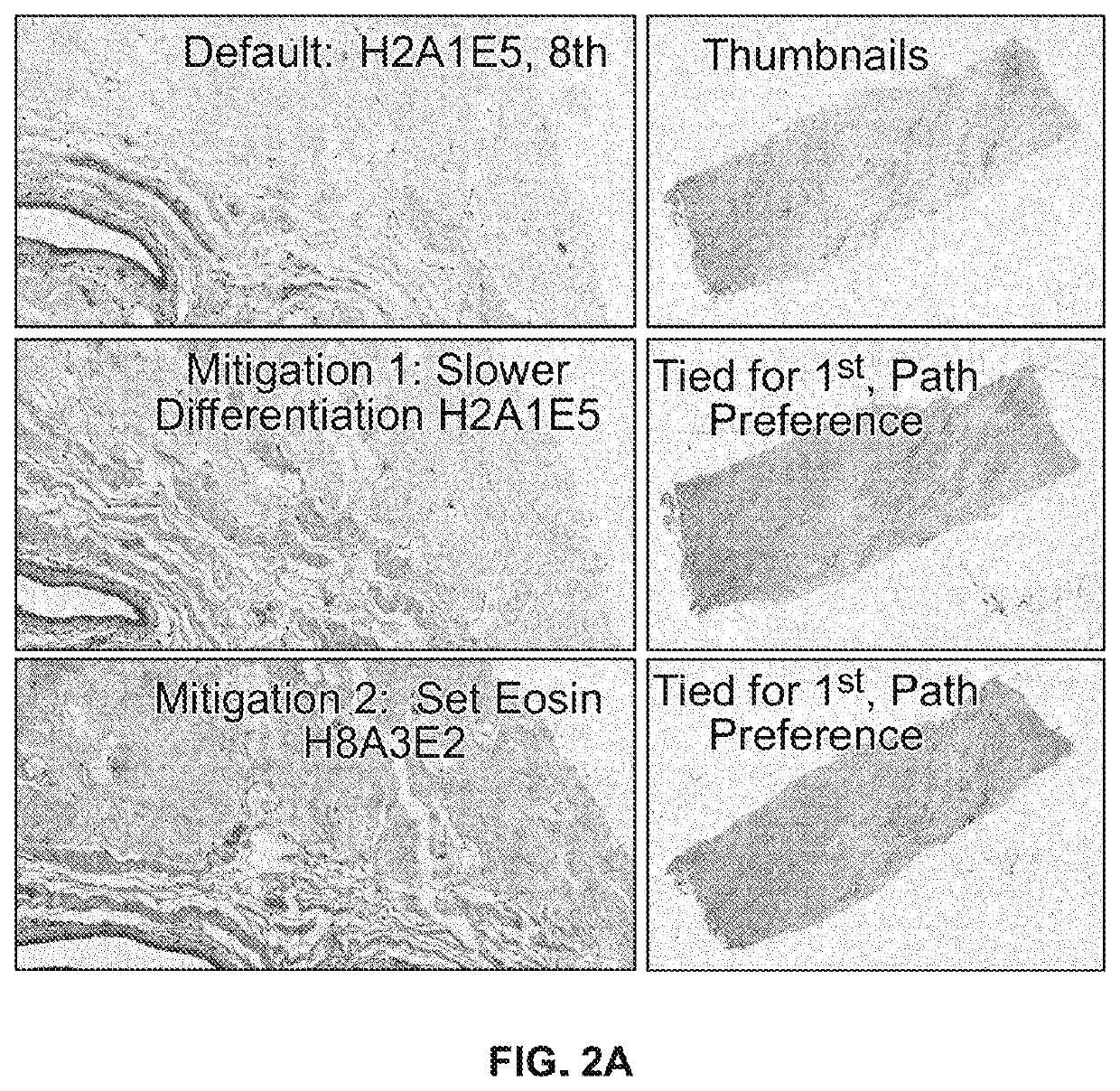Eosin staining techniques
a technology of eosin and staining, applied in the field of eosin staining techniques, can solve the problems of many tissues not retaining enough color after processing, and achieve the effects of improving the charge state of the tissue, increasing the tendency to hold onto the acidic dye, and improving the stain adheren
- Summary
- Abstract
- Description
- Claims
- Application Information
AI Technical Summary
Benefits of technology
Problems solved by technology
Method used
Image
Examples
example 1
ash Dispense With 2-Transfer Solution Dispenses—Dialability Determination
[0102]Staining runs were performed with an instrument in a Control configuration and with the alternative protocols set forth in Table 1. Also staining runs were performed using a “mitigation” technique where wash dispense steps are replaced by two (2) transfer solution steps for a total of four (4) transfer solution steps (see FIG. 3). The test configuration is achieved by a script change. The following staining runs were performed and then compared in each configuration:
TABLE 1Staining protocol runs, where theintegers 1 through 10 representrelative durations for which the specifiedfluid remains in contact with thespecimen, where lower integers representshorter amounts of time, and higherintegers represent longer time durations.StainingHematoxylinAcidEosinProtocolLevelWashLevelIncubation RationaleH2A1E5215DEFAULTH1A0E1101L, 0, LH1A0E5105L, 0, MH1A3E1131L, M, L (Lightest)H1A3E5135L, M, MH1A5E5155L, H, MH5A0E550...
example 2
in Replace Wash Differentiation with Two-Transfer Solution Dispenses: Diagnostic Clarity
[0120]This study was developed to determine if the mitigation procedure described in Example caused any unintended consequences in ability to diagnose tissue. Samples were prepared according to the same procedures as with Example 1.
[0121]The following were included when scoring for Diagnostic Clarity: (i) Stain artifacts caused by HE600 staining process; (ii) Stain issues (e.g. poor differentiation, hue, incorrect staining); and (iii) Other issues that could reasonably be caused by the staining process that can affect time and effort required to make a diagnosis.
[0122]Diagnostic Clarity was scored on a scale of −3 to 3 in a manner similar to that described in Example 1.
[0123]A slide pair consisted of Test and Control slides stained with the same staining protocol. Each slide in the pair was randomly labeled A or B; the slides were scored with slide B compared to slide A. Slides were scored for Di...
example 3
lability
[0132]This mucin staining study was derived to determine the impact of the staining protocol mitigations on the HE 600's ability to remove mucin staining. After screening several colon cases for mucin staining, we selected four cases, and stained over a hundred total slides at various hematoxylin solution, acid solution, and eosin solution settings (HAE settings) (see Example 1) with matching H and E to pair up high A and low A slides to see if the mucin staining is dialable (see Table 4).
TABLE 4Protocols and mitigationsused for the mucin studyHAE protocols run here:MitigationsH1A1E1nominal (EWWWTTL)H1A5E1Transfer (ETTTTL)H4A1E5Acid wash(HBEAWWWTTL)H4A3E5N / AH10A1E10N / AH10A3E10N / A
[0133]Slides run with the six protocols were paired up and scored with comparisons between H1A1E1-H1A5E1, H4A1E5-H4A3E5, and H10A1E10-H10A3E10. Results show that the transfer solution mitigation has minimal impact on mucin dialability compared to the nominal stain, with a slight increase in mucin sta...
PUM
 Login to View More
Login to View More Abstract
Description
Claims
Application Information
 Login to View More
Login to View More - R&D
- Intellectual Property
- Life Sciences
- Materials
- Tech Scout
- Unparalleled Data Quality
- Higher Quality Content
- 60% Fewer Hallucinations
Browse by: Latest US Patents, China's latest patents, Technical Efficacy Thesaurus, Application Domain, Technology Topic, Popular Technical Reports.
© 2025 PatSnap. All rights reserved.Legal|Privacy policy|Modern Slavery Act Transparency Statement|Sitemap|About US| Contact US: help@patsnap.com



